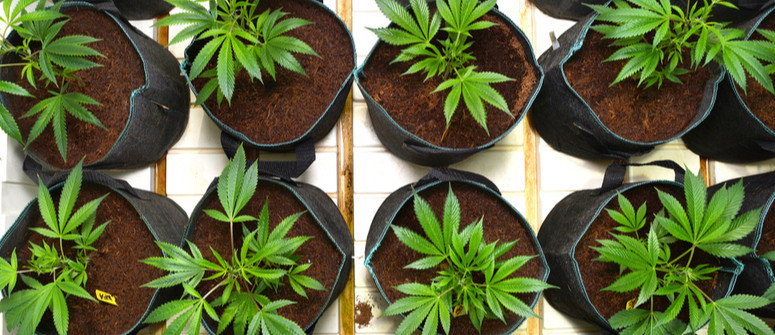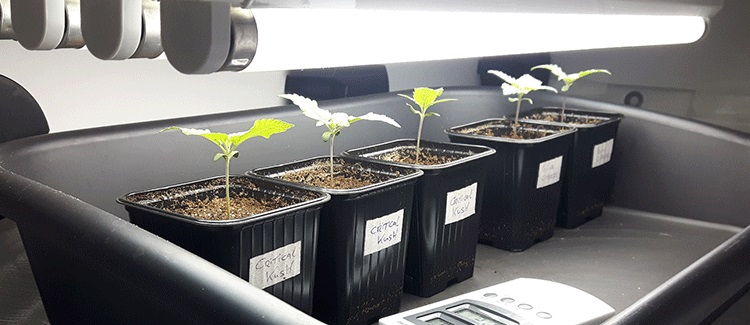Air-pots vs regular pots: which is better for cannabis?

While it may seem like a regular old container, the pot you grow your cannabis in is vital to its health and yield potential. Standard pots do the job for the most part, but Air-Pots and Smart Pots have become popular for having distinct advantages. We'll discuss the pros and cons of all these types so you can decide which is best for your setup!
Contents:
When you first set off on your cannabis growing adventure, one of the primary things you’ll have to consider is the pot your plant will grow in. Sure, standard ones get the job done. However, new, innovative varieties have reached the market, such as Air-Pots, that claim key advantages over the classic.
Air-Pots do indeed have the upper hand in some regards, but they also have drawbacks traditional pots don’t have to contend with. It all depends on your situation.
That being considered, let’s break down the pros and cons of both regular pots and Air-Pots to help you decide.
WHY CHOOSING THE RIGHT POT FOR CANNABIS MATTERS
Now, if you aren’t too familiar with the mechanisms behind growing cannabis plants, you may wonder why using a specific type of pot matters to begin with. After all, it just needs to hold the soil and plant, right?
Well, yes, but there’s another key task on its shoulders: allowing the roots access to oxygen. See, when plants grow in their natural environment, the soil is just loose enough to let a bit of oxygen flow through. As it turns out, the roots need this oxygen to stay alive and thrive.
In turn, when plants are grown in the ground, they have the ability to extend their root network far and wide, allowing them access to all the nutrients they need.
Naturally, a plant won’t want less oxygen or space because it’s being grown in a pot. It’s that combined need that makes choosing the right pot a vital task. If it’s too small or constricted, you could end up suffocating the roots and killing your plant in the process.
Pick the right pot, though, and you’ll see your cannabis plant develop into a vigorous specimen, offering you as many buds as its genetics allows. For those reasons, we believe the time, thought, and minor financial investment involved with selecting a high-quality growing container is more than worth it.

WHAT ARE REGULAR POTS?
If you’ve ever been somewhere with a garden, we imagine you’ve seen a standard plant pot before. They’re typically made of either plastic or ceramic, with some sort of dish beneath the container. They’ve worked for a long time, and we generally take them for granted.
Of course, a plant can still get enough oxygen to stay alive when grown in a regular pot. Would they have stuck around this long if plants couldn’t live in them? However, the grower has to ensure it’s not totally closed off, which is why drainage holes are necessary.
Those holes, drilled into the bottom of the pot, allow water to collect in the dish at the bottom. This simple mechanism effectively prevents the roots from drowning or developing rot.
With that, the system is maintained fairly well, but it’s not problem-free by any means. We’ll break down the pros and cons of these gardening mainstays to show you what we mean.
PROS OF REGULAR POTS
Let’s start by discussing the advantages of regular pots.
• Cheap: You’ll find plastic pots for low prices at any gardening store. Ceramic is more expensive, of course, but not too much more.
• Accessible: You can find pots in pretty much any market with a gardening section. Even if you don’t have a store around you, we’re sure you have a neighbour or family member with an extra.
• Tried and true: As we said before, people have grown cannabis in standard plant pots for a long, long time, and results are generally satisfactory.
CONS OF REGULAR POTS
All that considered, regular pots can run into quite a few problems.
• Risk of root rot: The drainage system we discussed before is only effective if you empty out the dish. If you’re not able to for some time, it could lead to water buildup and subsequent root rot. It’s fairly easy to prevent, but costly if you don’t.
• Potential root constriction: If your pot happens to be too small for your cannabis plant, the roots could end up getting constricted (root-bound) in their search for more space.
WHAT ARE AIR-POTS?
So, we threw the name out earlier, but we should explain what an Air-Pot is in greater detail. Available in various sizes, it is simply a pot with small holes spread across the entire outside, with a soft plastic wall that allows the roots to stretch out and search for oxygen without getting constricted. Other than that, it looks like a regular pot and serves the same purpose.
It’s important to note that “Air-Pots” are made by a singular brand called Superoots. There are other variants to consider as well—so-called Smart Pots and fabric pots (more on that below)—if you’re looking to buy outside of the original brand.
PROS OF AIR POTS
So, what are the advantages of this new type of pot?
• Roots prune themselves: When roots start to feel themselves getting close to their oxygen source, they harden at the tip—a process known as pruning. This allows them to stop growing while maintaining their health. Normally, especially with mother plants, cannabis growers have to do this manually, which can be tedious at best and exhausting at worst. With an Air-Pot, that all happens without extra effort on your part.
• Virtually no risk of becoming root-bound: Since the roots have their length naturally controlled, you don’t have to worry about them spiralling around in the pot. With this lack of interruption, your plant can focus more on healthy growth.
• Simple storage: Lastly, while this has more to do with the time before and after growing, Air-Pots are incredibly easy to store. Each one is firmly held together by a single screw, and removing that allows you to flatten it out and separate the pieces.
CONS OF AIR POTS
As convenient as all that sounds, there are some drawbacks to the design.
• Need to water plants more often: Since your soil is significantly more exposed to air, it’ll end up drying out fairly quickly. In turn, you’ll have to water your crop more frequently than you would with a standard pot.
• New watering technique: You can’t just water in the same way you would with a regular pot, either. Rather, you’ll have to slowly drip the water in over a longer period of time, allowing the soil to absorb it and making sure it doesn’t all pour out of the holes.
• More expensive than regular pots: Given the extra technology that goes into developing these, they end up being a little more expensive than standard pots. It all depends on the size, but you can get a three-pack of large gardening pots for around €32.
SMART POTS FOR OUTDOOR CANNABIS GROWERS
Lastly, if you’ve been doing your research, you may have discovered Smart Pots along the way. Like Air-Pots, these are a branded product. This time, however, the pot is made of breathable fabric, rather than plastic. While Smart Pot is considered the main innovator of these products, we’ll centre the discussion around fabric pots in general.
To start, like Air-Pots, fabric pots serve to let in more oxygen, allowing for natural pruning of the roots. This breathability also allows excess moisture to leave the pot, preventing potential overwatering. In turn, the roots become more fibrous and branch-like.
Smart Pots and fabric pots in general are often characterised by their size, as they’re quite wide and therefore suited for large plants. They don’t come with a drainage dish on the bottom, either. All that considered, we think these pots are best suited for those growing larger cannabis plants outside.
CHOOSING THE RIGHT POT FOR GROWING CANNABIS
Don’t be mistaken; while a certain pot may have advantages over the others, there isn’t going to be one container that’s right for everyone.
Indoor and outdoor growers will require different tools and equipment, as will small and large-scale growers. All you can do is consider the pros and cons of each, look at your own growing operation, and see what fits best!
.jpg)


.jpg)
